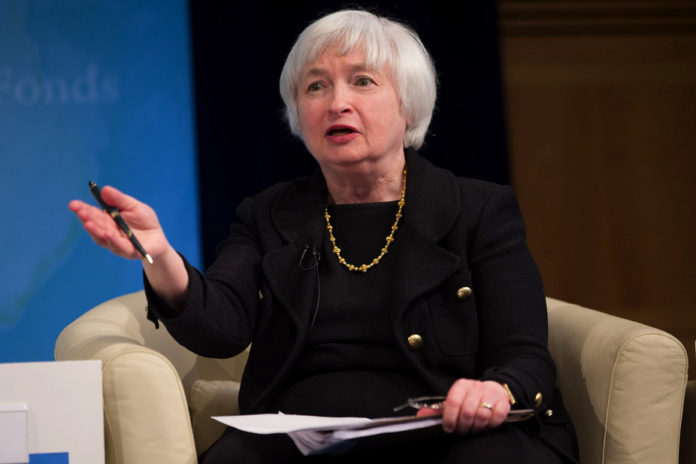
By W David McCausland, University of Aberdeen
As the US economy emerges from recession, the prospect of the US Federal Reserve raising interest rates grabs the attention of the financial markets more and more. US rates have been close to zero for a considerable time – part of a loose monetary stance in conjunction with a sustained policy of “quantitative easing” designed to support the economy through the recent recession. When the Fed switches tack, the waves will wash up around the globe.
So, what is likely to happen? As economies grow out of recession, unemployment falls and inflation increases. Like many central banks, the Fed has a target rate for inflation (of 2%), and considers its policy response in the context of this and other indicators, like unemployment. Essentially, interest rate rises are a way of cooling down the economy when there is evidence that there is likely to be strong and sustained inflation – for example when an economy is beginning to recover and wage inflation starts to take off.
Year on year growth in the US stands at an encouraging 2.5%, with investment at 19% of GDP (compared to 15% in the UK). However, US inflation at 1.7% is below the target rate of 2%. Were inflation to approach or exceed this target, the prospect of rate rises would increase.
On the other hand, US unemployment, at 5.9%, lies just above the estimated upper bound of the “natural” rate of unemployment (unemployment caused by the normal switching of jobs that occurs in a vibrant economy). When the rate of unemployment falls to these low levels, there will begin to be greater upward pressure on wages. Such wage inflation often occurs with a lag, prompting some to argue for rate rises to be brought forward. On balance, however, taking all this evidence together, rate rises are unlikely to be immediate, but may well be implemented in stages during 2015 if growth and inflation pick up.
Easing back on QE
The emergence of the US economy out of recession also heralds the end of quantitative easing – the purchase by the Federal Reserve of long-term government bonds, which served to release money into the economy, keep the price of bonds high and long term interest rates down. Since the recession, the US monetary base has increased three-fold and easy money is steadily being reigned in as economic conditions permit. The so-called “taper” – a gradual reduction in quantitative easing over time – is a deliberate strategy to allow markets time to adjust as support is withdrawn.

Bad memories for US homeowners.
Jeff Turner, CC BY
Another domestic effect from rate rises would be felt in loan rates and mortgage rates which could depress corporate investment and discourage firms from hiring new employees. This means that policy makers are rightly cautious about raising rates too quickly lest growth be choked off too fast. These effects may have a particular negative effect on, for example, youth unemployment or long-term unemployment. On the household side, pushing up mortgage payments may crowd out household spending on goods and services. And at worst could lead to increased repossessions. However, it may have a correcting effect of not allowing the housing market to overheat.
Going global
Though these domestic effects are important, the sheer size of the US economy means that the international impact is perhaps the more interesting and unpredictable beast. Rate rises increase the attractiveness of investing in the US. This boosts the capital account – essentially the investment portion – of the country’s balance of payments. In turn, this would lead to currency appreciation. A strengthening of the dollar means that dollar-denominated products become less competitive and this has an effect on trade flows with major trading partners such as China, the UK and EU. It is good news for firms in other countries exporting to the US, and also good news for domestic firms as imports from the US will be relatively more expensive.
Overall, net exports from the US should fall, deteriorating the US trade or current account, but improving the current account in countries that trade with the US. However, this positive prospect for international businesses has to be tempered by the fact that any cooling of US economic growth would mean US demand for foreign products would also be held back.
Although the US trade balance has not been in surplus since the 1970s, (see below) improvements in the trade deficit from around 5.8 per cent of GDP to around 3.6 per cent following the housing market crash have now begun to be reversed. The US is again increasingly importing more than it exports, and an appreciation of the dollar would reinforce this trend. This trade deficit is of course matched by trade surpluses of other countries, often much poorer than the US. Such capital flows from poor countries pose a challenge to dealing with global poverty.

Of course, the US is not to “blame” for being a safe place to invest, and having the technological and education infrastructure to support the inward investment. But it does highlight the important areas for policy makers in poorer countries. First, to improve education, to ensure inward investors have a high qualified workforce on which to draw. Second, to invest in research and development and measures to improve production efficiency. And importantly support legal frameworks to protect property rights and fight against corruption.
Any appreciation of the dollar also has implications for commodities that are typically denominated in dollars, oil being the obvious example. An increase in import prices for energy could have serious implications for energy-intensive businesses – particularly manufacturing. Since manufacturing is often the “engine of growth”, such a rise could hold back economic growth. Moreover, there are effects on countries that tie the value of their currencies to the dollar. China, for example, is the largest source of US imports. China’s intervention in the foreign exchange market has been a source of controversy for some time. Maintaining a weak currency has allowed China to protect its export sector, and though appreciation has taken place, the pace has been slow, leading to a widening trade surplus with the US. The Fed’s rate rises could actually make this problem worse, and heighten tensions between the two nations.
In short, Fed rate rises have important domestic and international effects – possibly cooling US growth, worsening the US trade deficit with trading partners, drawing capital from poorer regions, and moving exchange rates in a direction that may not ease tensions with China. The exact impact depends on timing, how far and how fast. We await the Fed’s decision with interest.
![]()
W David McCausland does not work for, consult to, own shares in or receive funding from any company or organisation that would benefit from this article, and has no relevant affiliations.
This article was originally published on The Conversation.
Read the original article.




















